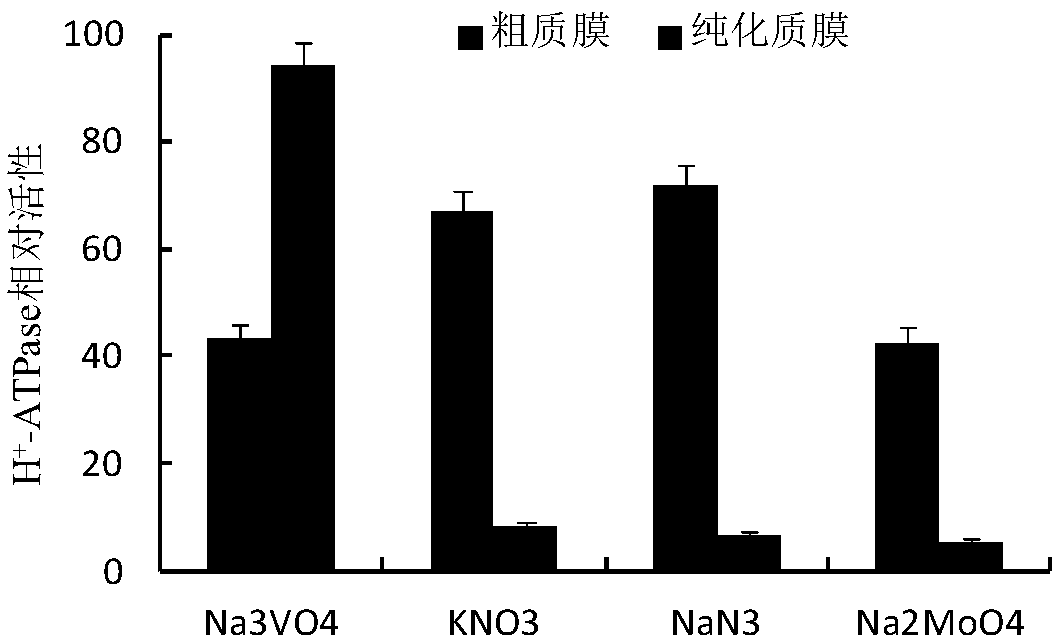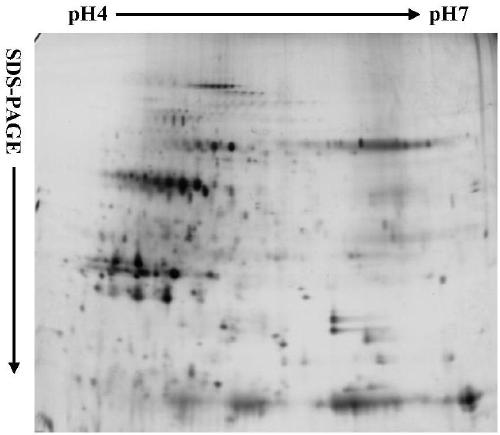Extracting method for phosphorylated protein suitable for two-dimensional electrophoresis of plasma membranes of rice leaves
A technology of phosphorylated protein and extraction method, applied in the field of extraction of plasma membrane phosphorylated protein from rice leaves, can solve the problem of difficulty in directly determining protein molecular weight and isoelectric point, loss of hydrophobic protein of plasma membrane protein, and abundance of plasma membrane phosphorylated protein. To avoid problems such as low degree of plasma membrane phosphorylated protein, less impurities and interfering substances in plasma membrane, good repeatability, less vertical tailing and less horizontal streaks
- Summary
- Abstract
- Description
- Claims
- Application Information
AI Technical Summary
Problems solved by technology
Method used
Image
Examples
Embodiment 1
[0035] Example 1 A method for extracting rice leaf plasma membrane phosphorylated proteins suitable for two-dimensional electrophoresis
[0036] 1. Rice planting and leaf collection
[0037] The rice was an indica rice line CO39. Paddy rice was sown in plastic pots filled with paddy field soil, at 24-26 °C, 14 h light (about 250 μmol m -2 ·s -1 ) in a growth chamber. Manage according to conventional methods, and sample when the fourth leaf is fully unfolded. The 3rd and 4th leaves were taken respectively, and the fresh weight of the leaves was quickly weighed. After quick freezing in liquid nitrogen, they were stored in a -70°C refrigerator for later use.
[0038] 2. Extraction of coarse plasma membrane from rice leaves
[0039] Weigh 80 g of rice leaves and grind to powder with liquid nitrogen. Add 260mL extraction buffer (containing 50mmol / LBTP-MES buffer, 250mmol / L sucrose, 2mmol / L EDTA, 10% v / v glycerol, 0.5% w / v BSA, 10mmol / L PMSF, 2mmol / L DTT, 0.6 %w / v PVP k-30, 4...
Embodiment 2
[0044] Example 2 Two-dimensional electrophoresis analysis and specificity analysis of rice leaf plasma membrane phosphorylated proteins
[0045] 1. Analysis of purification effect of rice leaf plasma membrane
[0046] The rice leaf plasma membrane was purified using 6.3% w / w PEG 3350 / Dextran T-500 two-phase partition system. The results showed that after 100 mg of crude plasma membrane protein was partitioned three times, the yield of the purified plasma membrane protein was About 2.71 to 3.21%.
[0047] Using different inner membrane marker enzymes (H + -ATPase)-specific inhibitors to treat crude plasma membranes and purify plasma membranes to evaluate the purity of plasma membranes. The specific steps are: add 5 μg plasma membrane protein to 0.5mL BTP-MES buffer (containing 30mmol / LBTP-MES pH 6.5, 5mmol / L MgSO 4 , 50mmol / L KCl, 0.02% (w / v) Brij 58, 5mmol / L Na 2-ATP), start the reaction, incubate at 30°C for 30min, add 2.5mL terminator [containing 0.5mmol / L PVP k30, 86mmo...
PUM
 Login to View More
Login to View More Abstract
Description
Claims
Application Information
 Login to View More
Login to View More - R&D
- Intellectual Property
- Life Sciences
- Materials
- Tech Scout
- Unparalleled Data Quality
- Higher Quality Content
- 60% Fewer Hallucinations
Browse by: Latest US Patents, China's latest patents, Technical Efficacy Thesaurus, Application Domain, Technology Topic, Popular Technical Reports.
© 2025 PatSnap. All rights reserved.Legal|Privacy policy|Modern Slavery Act Transparency Statement|Sitemap|About US| Contact US: help@patsnap.com



